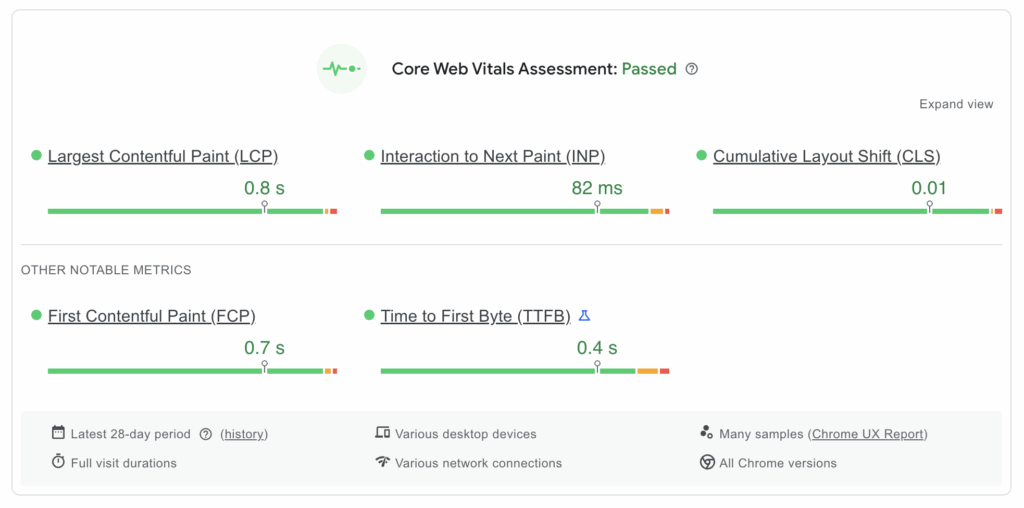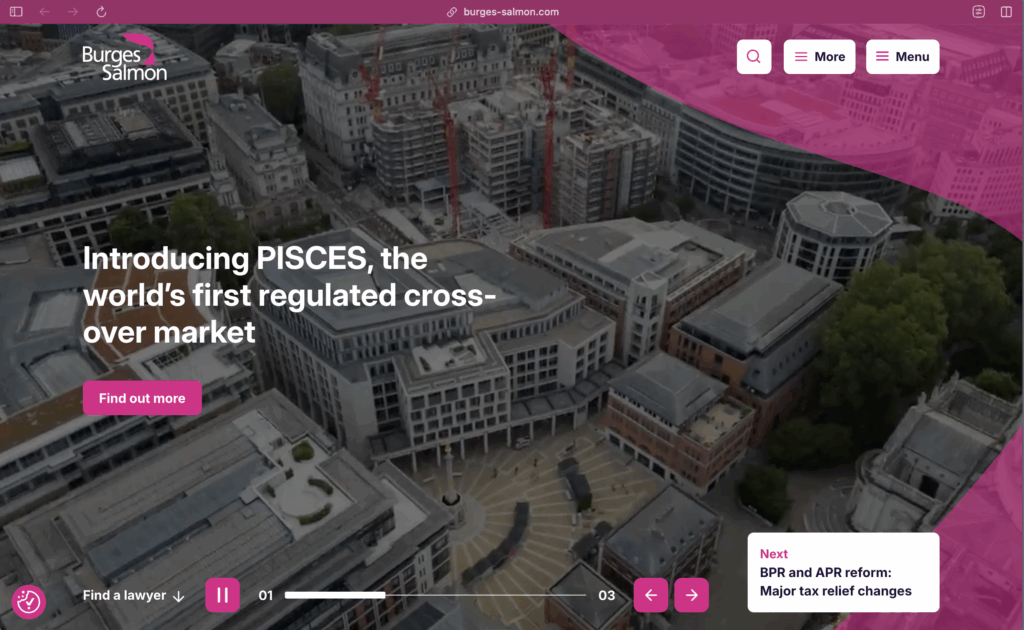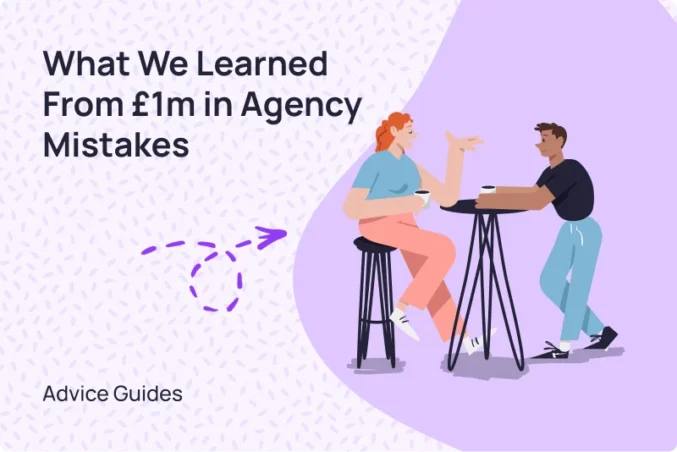Watch our full fireside chat from B2B Ignite in London where Matt Cann, Senior Digital Marketing Manager at Burges Salmon, shares the honest truth about their digital transformation journey and what it really takes to build a website that works for your business, not against it.
When Matt Cann joined Burges Salmon as Senior Digital Marketing Manager, he inherited something that perfectly encapsulates the hidden crisis facing B2B marketing teams today: a website that had become a career liability rather than a business asset.
“Our old website had been around for nearly seven, eight years,” Matt explained during our recent fireside chat at the B2B Ignite conference in London. “If you trace back its history and look at the old Burges Salmon website on launch day in 2016 and you look at that same website in January 2024, you will go, yes, the same one. And I would argue that you should not be able to say that eight years later with a website.”
But this isn’t just a story about an outdated website. It’s about what happens when brilliant marketing professionals get trapped by technology that should be enabling them to do their best work, and how the right partnership can transform both their daily experience and their career trajectory.

The Hidden Cost of Tech Debt in Professional Services
Burges Salmon stands as one of the UK’s top 50 law firms, with over 1,000 staff serving clients from offices in Bristol, London, Edinburgh, and Dublin. You’d expect their digital presence to reflect that calibre. Instead, Matt and his colleague Julian Wenban inherited what Julian described as a site that had become “a point of friction rather than a valuable business asset.”
The symptoms were familiar to anyone who’s worked in regulated industries: a text-heavy, difficult-to-navigate website with an outdated design that didn’t reflect the firm’s prestigious reputation. But the real problem ran deeper than aesthetics.
“The website before was a point of friction,” Matt shared during our B2B Ignite session. “People were reluctant to share and engage with the site.”
This created a vicious cycle that many marketing teams will recognise:
- Internal frustration – The marketing team was often viewed as a ‘blocker’ to sharing content because the site was so difficult to use
- Career anxiety – When stakeholders asked about digital performance, the answer was always about maintenance, never growth
- Budget questions – “I get asked, what’s that budget done in the last year? And I go, well, kept the website running, which is not a very good answer”
As Matt put it with characteristic honesty during our conversation: “That’s not what I want to do as a digital team.”
When “Best Technology” Becomes the Wrong Choice
During our fireside chat, Matt shared an insight that resonates with marketing directors across regulated industries. The problem wasn’t necessarily that they’d chosen bad technology, it was that they’d fallen into what he calls the “best technology versus best fit” trap.
“You get something that’s right for the time, and it’s not scalable,” Matt explained. “And if it’s not scalable, you have to keep ripping it up and starting again and ripping up and starting again, and you get into this debt of just having the tech in place.”
He used a memorable analogy to illustrate this: “The phrase was, you know, what you’ve got, what you’ve had built, or what is currently in place, is a Ferrari. What you need is a golf. And that’s not belittling a golf, but it’s saying, you know, if you’ve got family of four, Ferrari is not going to be any good whatsoever.”
This insight drove their decision to rebuild with WordPress, but not just any WordPress implementation. As both Matt and our team emphasised, platform choice is only part of the equation.
“It’s only the right platform if you build it in the right way, if you set it up in the right way,” Matt noted. “It’s not about saying, this is what we want. We want WordPress. That’s that. It’s about saying we want WordPress and using it as that like a framework.”
The Partnership That Changed Everything
What makes Matt’s story particularly compelling is that this wasn’t his first experience with digital transformation, or with Illustrate Digital. He’d previously brought us in to rescue a troubled website project at his former law firm.
“I’ve been here before, and I know the value of being with the right agency, being on the right technology, but also I’ve seen things go wrong before,” Matt shared during our conversation. “You know, I’ve called you into the rescue once before.”
This experience taught him something crucial: successful digital transformations aren’t just about technology choices, they’re about finding partners who understand the unique pressures of regulated industries and can navigate the complexity of stakeholder management in partnership structures.
“Working with partnership structures is very different,” Matt explained to our B2B Ignite audience. “I don’t know how many people in this room have partnership structure that you have to work with, but it’s a very different model of operating in terms of the hoops you have to jump through.”
The collaborative approach that emerged reflects our belief that the best agency relationships happen when expertise meets partnership:
- Exceptional problem-solving – “Simon was an absolute legend. He really went over and above. He has a good way of communicating things, cool and calm.”
- Consultative guidance – “We felt pushback in a consultative way. They were open to changes and suggestions, but also provided expert guidance. This made it feel like a partnership.”
- Shared ownership: “It felt like a shared endeavour, and that we were in it together.”
Four Pillars of Digital Transformation Success
The rebuild delivered measurable improvements across what Matt identified as four critical areas during our conference discussion:
1. Cost Reduction
“There’s not a licence attached,” Matt explained when discussing WordPress versus their previous platform. “Our previous CMS system, before we touched it every year, there was just a big fat chunk of change coming out of the business.”
But the cost savings went beyond licensing. The new platform eliminated the vendor lock-in that had trapped them in expensive maintenance cycles with limited flexibility.
2. Development Agility
“The development agility is massive in terms of being able to work with you, work with our account manager, look at all the exciting things coming down the pipeline… and that whole development testing cycle time frame just gets shortened a lot.”
This agility enabled Burges Salmon to respond quickly to business needs rather than waiting months for simple changes.
3. Content Agility
“Give my team the tweaks, the changes, the suggestions, and then again, looping that back with the development side of the agility… is huge.”
The intuitive content management system transformed the marketing team from ‘blockers’ into enablers of digital communication.
4. Scalability
“If you add all those four together, you know, development agility, content agility, scalability and just the pure financial cost reduction, then the opportunities that allows to present are massive.”

Creating Seamless Experiences in Complex B2B Journeys
One of the most sophisticated aspects of the Burges Salmon transformation involved addressing the complexity of modern B2B customer journeys. As Matt explained during our chat:
“One of the key things about the digital strategy for me at the moment is getting that seamless user experience, so from the first digital touch point right through to them becoming client or the last digital touch point.”
This required sophisticated integration work to connect previously siloed systems:
Careers Integration – “We’ve fully integrated now with our job board platform and before us totally separate… what we’ve done is just shifted that split right to the last point, so right up until someone clicked apply and goes to the job application, you’re on one platform.”
Content Integration – “We’ve leveraged the APIs. We’ve leveraged working with you guys, working with the other platform… that user journey in terms of someone connecting with someone on LinkedIn, seeing their post, clicking through to that post, then looking at their profile, is all one journey.”
For a firm with 29 different service and sector lines, this level of integration was crucial.
“It’s not just about supporting the firm digital strategy. It’s about having something in place that allows us to do that, and then allows us to work with BD and sales and the teams and make sure we’re also being able to support those 29 mini strategies.”
The Transformation Results: From Friction to Pride
The results speak for themselves. As Matt shared during our conversation, the transformation delivered improvements that could be measured both quantitatively and qualitatively:
Internal Pride – “The design is what we’re really proud of, it’s completely transformed how we present ourselves online… The team is actually proud of the site now, which wasn’t the case before.”
Improved Metrics – Better dwell times, reduced bounce rates, and increased page depth tracked through comprehensive analytics.
Enhanced Client Engagement – “Engagement of people with the site is much better than it was. We’re tracking the basics of accessibility, core web vitals, and lead generation, but also looking deeper at page depth, time per visit, and the entire client journey.”
Strategic Capability – Perhaps most importantly, the transformation freed Matt’s team from maintenance mode, “Without that agility, we wouldn’t be able to bring anything to the market.”

Looking Forward: From Maintenance to Innovation
With their foundation now solid, Burges Salmon can focus on innovation rather than firefighting. During our conference discussion, Matt shared their forward-looking roadmap:
- AI Implementation – Both front-end capabilities and back-end efficiency improvements
- Enhanced Personalisation – Leveraging their robust data foundation
- Automation – Streamlining workflows between platforms
- Micro Sites – Campaign-specific sites leveraging their multi-site capability
“Now we’ve got the foundations in place,” Matt explained, “it’s how can we use it to better personalise and how can we use it to better automate.”
This shift from reactive maintenance to proactive innovation illustrates the broader transformation that happens when marketing teams are freed from technology constraints.
The Broader Lesson for B2B Marketing Leaders
Matt’s story illuminates a critical challenge facing marketing professionals in regulated industries. Too often, they find themselves trapped by technology choices that seemed reasonable at the time but became strategic liabilities as business needs evolved.
The key insights from Burges Salmon’s transformation:
Technology debt compounds quickly. What seems like a reasonable platform choice can become a career-limiting constraint within just a few years if it lacks the flexibility to evolve with business needs.
Partnership matters as much as platform. The right technology implemented poorly creates more problems than the wrong technology implemented well. Choose partners who understand your industry’s unique pressures.
Agility enables strategy. When technology gets out of the way, marketing teams can focus on value creation rather than maintenance and firefighting.
Integration is everything. Modern B2B journeys demand seamless experiences across multiple touch points, your website must connect elegantly with your broader technology ecosystem.
The human element matters. As Matt emphasised throughout our conversation, successful digital transformation isn’t just about technology, it’s about finding partners who have your back.

Why This Matters for Your Career
Perhaps the most powerful aspect of Matt’s story is how it illustrates the career impact of getting digital strategy right. Instead of explaining why they kept a website running, Matt’s team can now demonstrate measurable contributions to business growth.
“If you’ve built it right, if you’ve got the right agency relationship, hosting everything in place, then it’s how can’t it be leveraged?” Matt reflected during our chat. “Because you know, our website does three things: it’s lead generation, it’s validation, and it’s also career routes as well.”
This transformation from technology victim to strategic enabler represents the difference between surviving and thriving as a marketing professional in today’s complex digital landscape.
Ready to Transform Your Digital Foundation?
If Matt’s journey resonates with your current challenges – whether you’re dealing with tech debt, complex stakeholder requirements, or the need for greater digital agility – you’re not alone. The symptoms he described are remarkably common across regulated industries, from legal and financial services to healthcare and professional services.
The good news is that transformation is possible, even in the most complex organisational environments. Our enterprise WordPress development expertise, combined with our deep understanding of regulated market requirements, has helped organisations like Burges Salmon transform their digital foundation from a source of anxiety into a competitive advantage.
Want to explore whether our approach might work for your organisation? We’d recommend starting with a comprehensive WordPress audit to understand where your current platform stands against industry best practices, or consider an agency migration if you’re ready for a complete transformation.
Contact us today to discuss your specific challenges and explore whether a partnership approach to digital transformation might be right for your team.
Because life’s too short to work with an agency or technology stack that doesn’t have your back.
Frequently Asked Questions
Q: How long did the Burges Salmon website transformation take? A: The comprehensive rebuild was part of an 18-month to two-year strategic programme that established robust foundations before moving to growth-focused initiatives. The timeline included extensive stakeholder consultation, user research, and careful attention to brand guidelines, all crucial for success in complex organisational environments.
Q: What makes WordPress suitable for top-tier law firms like Burges Salmon? A: When implemented by experienced agencies who understand regulated market requirements, WordPress can deliver enterprise-grade security, compliance features, and the flexibility needed for complex stakeholder environments. The key is working with partners who can implement appropriate standards, controls, and integrations rather than relying upon off-the-shelf solutions.
Q: How do you know if your current website platform is creating tech debt? A: Key indicators include excessive complexity in your tech stack, unable to organise and consolidate your important data, spending most of your budget on maintenance rather than growth initiatives, difficulty implementing new features when business needs change, and teams being reluctant to share or engage with your site. If your platform hasn’t evolved significantly in several years, that’s often a warning sign.
Q: What’s the difference between “best technology” and “best fit technology”? A: Best technology refers to cutting-edge or feature-rich platforms that might seem impressive but don’t match your actual needs, resources, or growth plans. Best fit technology means choosing the solution that aligns with your organisation’s specific requirements, stakeholder complexity, and long-term strategic goals. As Matt’s Ferrari vs Golf analogy illustrates, the most practical solution often delivers better long-term value.
Q: How important is the agency relationship in digital transformation projects? A: Critical. Matt’s experience working with Illustrate Digital across two different organisations demonstrates that successful digital transformation isn’t just about technology choices, it’s about finding partners who understand your industry’s unique pressures, can navigate complex stakeholder environments, and will genuinely have your back when challenges arise. The best relationships feel like partnerships rather than vendor transactions.





